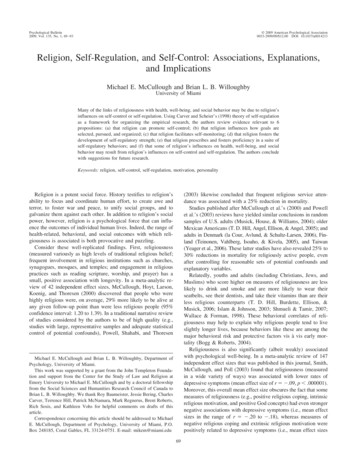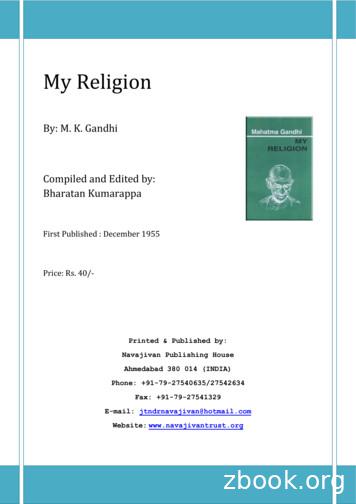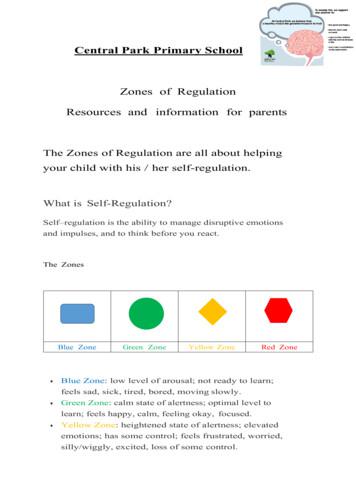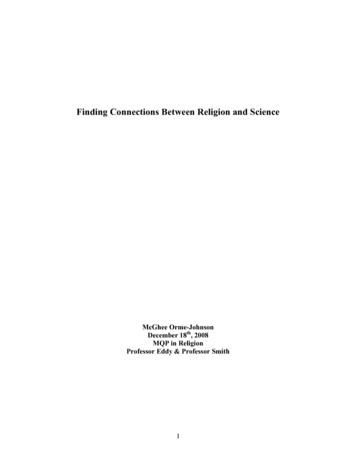Religion, Self-Regulation, And Self-Control: Associations .
Psychological Bulletin2009, Vol. 135, No. 1, 69 –93 2009 American Psychological Association0033-2909/09/ 12.00 DOI: 10.1037/a0014213Religion, Self-Regulation, and Self-Control: Associations, Explanations,and ImplicationsMichael E. McCullough and Brian L. B. WilloughbyUniversity of MiamiMany of the links of religiousness with health, well-being, and social behavior may be due to religion’sinfluences on self-control or self-regulation. Using Carver and Scheier’s (1998) theory of self-regulationas a framework for organizing the empirical research, the authors review evidence relevant to 6propositions: (a) that religion can promote self-control; (b) that religion influences how goals areselected, pursued, and organized; (c) that religion facilitates self-monitoring; (d) that religion fosters thedevelopment of self-regulatory strength; (e) that religion prescribes and fosters proficiency in a suite ofself-regulatory behaviors; and (f) that some of religion’s influences on health, well-being, and socialbehavior may result from religion’s influences on self-control and self-regulation. The authors concludewith suggestions for future research.Keywords: religion, self-control, self-regulation, motivation, personality(2003) likewise concluded that frequent religious service attendance was associated with a 25% reduction in mortality.Studies published after McCullough et al.’s (2000) and Powellet al.’s (2003) reviews have yielded similar conclusions in randomsamples of U.S. adults (Musick, House, & Williams, 2004); olderMexican Americans (T. D. Hill, Angel, Ellison, & Angel, 2005); andadults in Denmark (la Cour, Avlund, & Schultz-Larsen, 2006), Finland (Teinonen, Vahlberg, Isoaho, & Kivela, 2005), and Taiwan(Yeager et al., 2006). These latter studies have also revealed 25% to30% reductions in mortality for religiously active people, evenafter controlling for reasonable sets of potential confounds andexplanatory variables.Relatedly, youths and adults (including Christians, Jews, andMuslims) who score higher on measures of religiousness are lesslikely to drink and smoke and are more likely to wear theirseatbelts, see their dentists, and take their vitamins than are theirless religious counterparts (T. D. Hill, Burdette, Ellison, &Musick, 2006; Islam & Johnson, 2003; Shmueli & Tamir, 2007;Wallace & Forman, 1998). These behavioral correlates of religiousness may help to explain why religious people tend to liveslightly longer lives, because behaviors like these are among themajor behavioral risk and protective factors vis à vis early mortality (Bogg & Roberts, 2004).Religiousness is also significantly (albeit weakly) associatedwith psychological well-being. In a meta-analytic review of 147independent effect sizes that was published in this journal, Smith,McCullough, and Poll (2003) found that religiousness (measuredin a wide variety of ways) was associated with lower rates ofdepressive symptoms (mean effect size of r .09, p .000001).Moreover, this overall mean effect size obscures the fact that somemeasures of religiousness (e.g., positive religious coping, intrinsicreligious motivation, and positive God concepts) had even strongernegative associations with depressive symptoms (i.e., mean effectsizes in the range of r .20 to .18), whereas measures ofnegative religious coping and extrinsic religious motivation werepositively related to depressive symptoms (i.e., mean effect sizesReligion is a potent social force. History testifies to religion’sability to focus and coordinate human effort, to create awe andterror, to foster war and peace, to unify social groups, and togalvanize them against each other. In addition to religion’s socialpower, however, religion is a psychological force that can influence the outcomes of individual human lives. Indeed, the range ofhealth-related, behavioral, and social outcomes with which religiousness is associated is both provocative and puzzling.Consider these well-replicated findings. First, religiousness(measured variously as high levels of traditional religious belief;frequent involvement in religious institutions such as churches,synagogues, mosques, and temples; and engagement in religiouspractices such as reading scripture, worship, and prayer) has asmall, positive association with longevity. In a meta-analytic review of 42 independent effect sizes, McCullough, Hoyt, Larson,Koenig, and Thoresen (2000) discovered that people who werehighly religious were, on average, 29% more likely to be alive atany given follow-up point than were less religious people (95%confidence interval: 1.20 to 1.39). In a traditional narrative reviewof studies considered by the authors to be of high quality (e.g.,studies with large, representative samples and adequate statisticalcontrol of potential confounds), Powell, Shahabi, and ThoresenMichael E. McCullough and Brian L. B. Willoughby, Department ofPsychology, University of Miami.This work was supported by a grant from the John Templeton Foundation and support from the Center for the Study of Law and Religion atEmory University to Michael E. McCullough and by a doctoral fellowshipfrom the Social Sciences and Humanities Research Council of Canada toBrian L. B. Willoughby. We thank Roy Baumeister, Jessie Bering, CharlesCarver, Terrence Hill, Patrick McNamara, Mark Regnerus, Brent Roberts,Rich Sosis, and Kathleen Vohs for helpful comments on drafts of thisarticle.Correspondence concerning this article should be addressed to MichaelE. McCullough, Department of Psychology, University of Miami, P.O.Box 248185, Coral Gables, FL 33124-0751. E-mail: mikem@miami.edu69
70MCCULLOUGH AND WILLOUGHBYin the range of r .14 to .16). It is important to note that thereligiousness– depression association was as strong among AfricanAmericans as it was among Americans of European descent andNorthern Europeans, suggesting that the association is not limitedto the White Protestants who are overrepresented in U.S. studies(Smith et al., 2003).Similarly, a 2-decades-old meta-analysis (Witter, Stock, Okun,& Haring, 1985) concluded that religiousness was positively associated with subjective well-being (mean effect size of r .16).A more recent meta-analytic review of data from 49 studies (Ano& Vasconcelles, 2005) also concluded that “positive” forms ofreligious coping (e.g., benevolent religious reappraisals of stressors, collaborative religious coping, and active religious surrender)were positively associated with scores on measures of positivepsychological outcomes, such as satisfaction with life and happiness (mean r .33), and negatively associated with measures ofnegative outcomes, such as anxiety and depression (mean r .12). “Negative” forms of religious coping (e.g., appraising one’sdifficulties as due to demonic influences or God’s punishment), onthe other hand, were not associated with positive outcomes (meanr .02), but they were positively associated with negative outcomes (mean r .22).Consider also the negative association of religiousness withcrime, delinquency, and youth sexual behaviors, all of which arerisk factors for poor outcomes in adulthood. A meta-analysis of 60effect sizes revealed that religiousness is associated with lowerrates of crime and delinquency (mean effect size of r .12) andis even more strongly associated with lower rates of “victimless”crimes such as gambling and drug use (Baier & Wright, 2001).Moreover, studies of representative samples of U.S. youths showthat White, African American, Hispanic, and Asian Americanadolescents who are religious (measured as frequency of churchattendance and self-rated importance of religion) wait longer before first intercourse (Regnerus, 2007; Rotosky, Regnerus, &Wright, 2003), have lower rates of having ever given or receivedoral sex (Regnerus, 2007), and have lower rates of ever havingbeen pregnant (Nonnemaker, McNeely, & Blum, 2003). Recentsystematic and meta-analytic reviews (Lucero, Kusner, Speace, &O’Brien, 2008; Rotosky, Wilcox, Comer Wright, & Randall, 2004)concur with these conclusions.Religious youths also tend to have higher grade point averagesand standardized test scores than do their less religious counterparts (Regnerus, 2000; Regnerus & Elder, 2003). Indeed, a metaanalysis of 15 studies on the association of religiousness andschool achievement in Black and Hispanic American youths (Jeynes, 2002) found that religiousness was positively associated withgrade point average (mean r .21) and achievement test scores(mean r .15).The association of religion with measures of social adjustmentalso extends to the marital realm. A meta-analytic review ofdozens of studies showed that married religious adults are morelikely to stay married over time (mean correlation of religiousservice attendance with divorce, r .13) and have higher levelsof marital satisfaction (mean effect size of r .15) and maritalcommitment (mean effect size r .19; Mahoney, Pargament,Tarakeshwar, & Swank, 2001).As this brief survey of well-replicated findings shows, manymeasures of religiousness are associated consistently (albeit, inmost cases, weakly) with a wide variety of outcomes that arerelevant to health, well-being, achievement, and social flourishing.However, these associations present an interesting puzzle, becausean overarching explanatory mechanism that might explain themhas not been identified. Historically, theorists have focused onexplanations such as (a) religion’s ability to prescribe healthpromoting behaviors and proscribe health-compromising ones(T. D. Hill, Burdette, Ellison, & Musick, 2006; Strawbridge,Shema, Cohen, & Kaplan, 2001); (b) religion’s ability to confersocial support (Joiner, Perez, & Walker, 2002); (c) religion’sability to socialize children to conform with society’s norms (Baier& Wright, 2001); and (d) religion’s ability to promote effectivecoping with stress (Ano & Vasconcelles, 2005; Pargament, 1997).To be sure, all of these explanations are important, but the list isincomplete. George, Larson, Koenig, and McCullough (2000) surmised that only 35% to 50% of the relationship between religiousness and various measures of health and well-being could beexplained on the basis of the explanatory variables such as socialsupport, health behaviors, and coping. If George et al.’s 35% to50% estimate comes close, then social scientists have only goneone third to one half of the way in explaining scientifically howreligion affects health, well-being, and social behavior. Clearly,there is room for conceptual innovation in this research domain.Goals of the Present ArticleIn this article, we provide a systematic and comprehensivereview of empirical evidence surrounding an underappreciatedpsychological process that may help explain why religiouspeople tend to live slightly longer lives; suffer less from depressive symptoms; avoid trouble with sex, drugs, and thepolice; do better in school; enjoy more stable and more satisfying marriages; and more regularly visit their dentists. Specifically, we review evidence that is relevant to the ideas that (a)some types of religious belief, behavior, and cognition fosterself-regulation and, more specifically, self-control and (b) thatit is partly through its associations with self-regulation andself-control that religion obtains its associations with health,well-being, and social behavior. The idea that religion is effective at reining in socially non-normative behavior and promoting socially normative behavior has a long history in the scientific study of religion (Durkheim, 1965/1912; Malinowski,1935). In contrast, the notion that religion fosters selfregulation and control of the self has attracted little theoreticalattention (for interesting exceptions, see Ainslie, 2004; Geyer &Baumeister, 2005). Nevertheless, as our review indicates, manypropositions arising from these basic ideas appear to enjoyempirical support (though that support is preliminary in someinstances).Self-regulation and self-control are crucial for success in manylife domains. College students with high self-control have betterpsychological adjustment, better interpersonal relationships, andbetter performance on achievement-related tasks (Tangney,Baumeister, & Boone, 2004), and self-control appears to be abetter predictor of academic performance than even intelligence(Duckworth & Seligman, 2006). People with high self-control alsohave lower alcohol and substance use, lower rates of crime anddelinquency, better self-assessed health, and better health behaviors (for a review, see Baumeister & Vohs, 2004). Moreover,Conscientiousness and its varied facets (including, notably, self-
RELIGION, SELF-REGULATION, AND SELF-CONTROLcontrol) are negatively associated with many health-risk behaviors,including physical inactivity, attempted suicide, risky sex, unhealthy eating, substance use, risky driving, and violence (Bogg &Roberts, 2004).Research has also shown that young children who do well atdelaying gratification (i.e., forgoing a small reward in the presentso that they might obtain a larger reward after time has passed)perform better years later on measures of academic achievementand social adjustment (Mischel, Shoda, & Rodriguez, 1989). Somesocial scientists consider delay of gratification to be an importantdynamic underlying the behavioral choices of people who believein an afterlife in which their behavior during this life will bejudged. For people with strong beliefs in such an afterlife, it wouldindeed be rational to deny short-term gains that might come fromengaging in behavior that is proscribed by one’s religion becausethe long-term (eternal) gains of not engaging in the behavior mightoutweigh the short-term gains associated with engaging in thebehavior (Azzi & Ehrenberg, 1975; Iannaccone, 1998). In keepingwith this idea, Turkish (Muslim) undergraduates who are highlyreligious tend to report considering the future in their presentdecision making to a greater extent than do less religious students
Keywords: religion, self-control, self-regulation, motivation, personality Religion is a potent social force. History testifies to religion s ability to focus and coordinate human effort, to create awe and terror, to foster war and peace, to unify social groups, and to galvanize them against each other. In addition to religion s social
FAMILY AND RELIGIOUS STUDIES SYLLABUS (FORMS 1 – 4) 9 Religion and the Liberation Struggle-Chimurenga/Umvukela Religion, Rights and Social Responsibility Religion and Conflict management 7.0 SCOPE AND SEQUENCE 7.1 TOPIC 1: RELIGION SUB-TOPIC FOR M 1 FORM 2 FORM 3 FORM 4 Concept of Religion Definition, types and c haracteristics of religion Different religions in Zimbabwe .
religion. However, religion cannot be defined except by the characteristics by which are found wherever religion itself is found.4 Nevertheless, the one aspect of religion that must be agreed upon, and is required to remotely be considered as religion, is that it is a belief system held by a group of
Religion which takes no account of practical affairs and does not help to solve them, is no religion. Young India, 7-5-'25, p. 164 Every activity of a man of religion must be derived from his religion, because religion means being bound to God,
Religion in the Schools Task Force guided this initiative.6 Overview of Guidelines Part One addresses why it is important to teach about religion, and Part Two outlines ways to teach about religion in constitutionally sound ways. Part Three is an overview of approaches to teaching about religion
Curriculum Guide Revised December 2017. Course Offerings Department 9th 10th 11th 12th Religion Religion 1 Religion 2 Religion 3 Religion 4 Religion 4/ Leadership . Freshmen will become familiar with the Common Application to understand the elements considered by colleges for admission.
Zones of Regulation Resources and information for parents . The Zones of Regulation are all about helping your child with his / her self-regulation. What is Self-Regulation? Self–regulation is the ability to manage disruptive emotions and impulses, and
Religion and science serve different purposes to different people. As such, Latour’s view is only one way of describing the purposes of religion and science, and there could be other views that allow for more of a compliment between religion and science. I would suggest that religion and science have different purposes than what
Andreas Werner The Mermin-Wagner Theorem. How symmetry breaking occurs in principle Actors Proof of the Mermin-Wagner Theorem Discussion The Bogoliubov inequality The Mermin-Wagner Theorem 2 The linearity follows directly from the linearity of the matrix element 3 It is also obvious that (A;A) 0 4 From A 0 it naturally follows that (A;A) 0. The converse is not necessarily true In .























